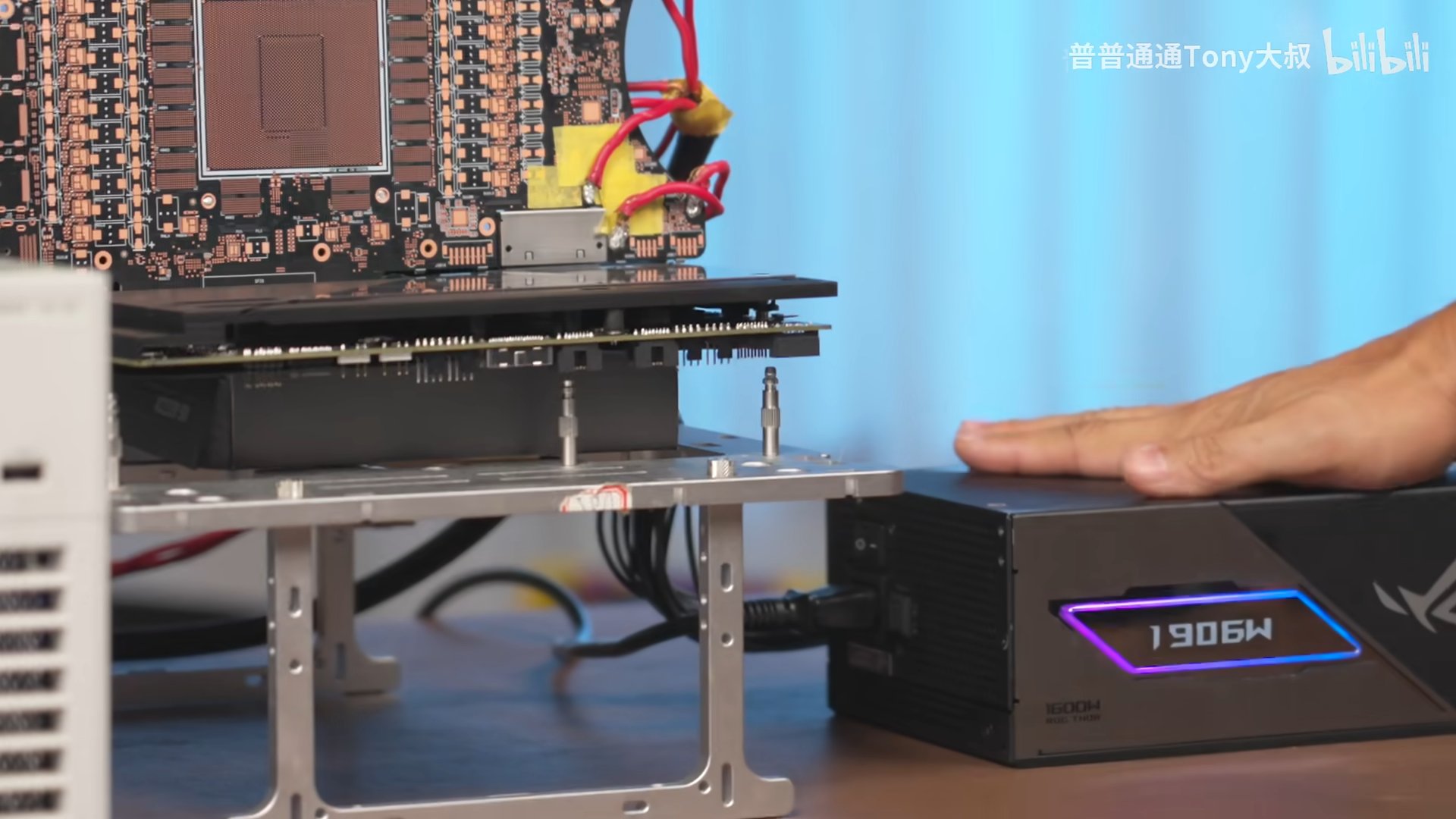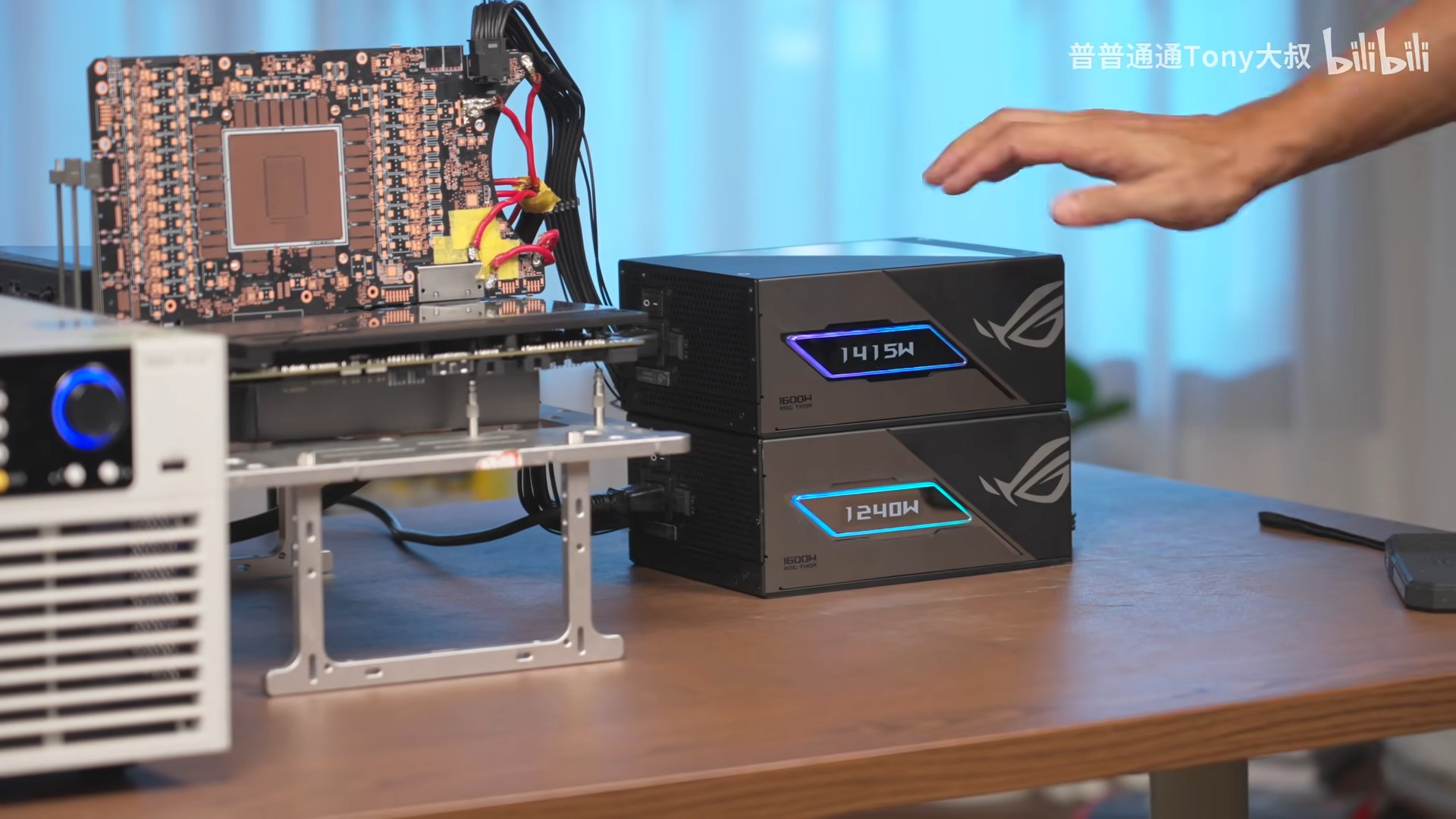Asus RTX 5090 BTF 2.5 GPU successfully pulls over 1,900W in extreme test — proprietary metal power connector kept its cool, unlike plastic 16-pin alternative
16-pin and GC-HPWR can also work in unison to split the RTX 5090's power load.

A new Bilibili video highlights how substantial power flows through the 16-pin (12VHPWR) and Asus's unique GC-HPWR connectors — showcasing the strengths and peculiarities of the power connectors on the ROG Astral GeForce RTX 5090 BTF Edition graphics card.
The BTF (Back to the Future) hidden connector design from Asus is now at the 2.5 revision. The main update is that the GC-HPWR power connector is now detachable, allowing users to choose between it and the 16-pin power connector. This change is beneficial, as it advances the BTF standard and addresses the earlier design limitation where the GC-HPWR connector was non-removable, restricting users to the BTF ecosystem for as long as they used the card. Asus provides a small tool to remove and store the GC-HPWR power connector.
The video, initially spotted by Uniko's Hardware, features Tony Yu — Asus China's General Manager (who's known for his extreme testing). In it, he aims to showcase the durability of the GC-HPWR power connector. For reference, Asus designed this connector to handle up to 1,000W. During a 10-minute test drawing about 670W, the temperature of the GC-HPWR connector stayed between 30 and 35 degrees Celsius. The result is pretty good, especially considering that's, more or less, the maximum power consumption of a GeForce RTX 5090.

For a more hardcore test, Yu pumped around 1,300W through the GC-HPWR power connector, but it didn't flinch. He recorded temperatures reaching up to 38 degrees Celsius. In the following test, he set the Chroma load tester to 150A, which is three times higher than the 16-pin power connector's specifications, causing the power consumption to exceed 1,900W. The power cables' temperatures ranged from 68 to 70 degrees Celsius, while the GC-HPWR power connector stayed around 41 degrees Celsius.
The following experiment was interesting because the 16-pin and GC-HPWR power connectors can work together to distribute power on the GeForce RTX 5090. Yu's test showed about 370W flowing through each connector. For additional testing, Yu increased the load to 200A, at which point the 16-pin and GC-HPWR connectors drew roughly 1,400W and 1,200W from the two power supplies.
Currently, Asus does not plan to have both the 16-pin and GC-HPWR power connectors power graphics cards in its retail products. The company believes most consumers will likely stick to one power connector. It's unlikely a typical user will leverage both. You would only need so much power if you're an extreme overclocker pushing the GeForce RTX 5090 to its last breath. In fact, overclocking-focused GeForce RTX 5090 models already feature two 16-pin power connectors for this purpose.
However, Yu's demonstration indicates that the 16-pin and GC-HPWR power connectors can play nicely together. If future graphics cards have even higher power consumption, Asus' combination might not be just a fantasy.
Get Tom's Hardware's best news and in-depth reviews, straight to your inbox.
Follow Tom's Hardware on Google News to get our up-to-date news, analysis, and reviews in your feeds. Make sure to click the Follow button.

Zhiye Liu is a news editor, memory reviewer, and SSD tester at Tom’s Hardware. Although he loves everything that’s hardware, he has a soft spot for CPUs, GPUs, and RAM.
-
setx Pretty much anything is better than that total failure of connector.Reply
Though I don't quite like routing 2kW on motherboard... -
SomeoneElse23 Reply
Agreed. That's a scary amount of power.setx said:Pretty much anything is better than that total failure of connector.
Though I don't quite like routing 2kW on motherboard... -
artk2219 Reply
It also puts you at the maximum amount of power that a US 120V connector can carry. If anything else is on that circuit while that PC is pulling 1900W, its definitely going to trip. Definitely less of an issue on most 210+ systems, but thats still a ton of power from one system.setx said:Pretty much anything is better than that total failure of connector.
Though I don't quite like routing 2kW on motherboard... -
John Nemesh Honestly, BTF seems like the best solution for modern cards. If I were building a new system, I would absolutely choose a motherboard and graphics card with BTF!Reply -
helper800 Reply
For continuous loads, a 15 amp 120V circuit is only rated for 1440w. A 20 amp 120v circuit is only rated for 1920w continuous. Most circuits I have ever had were 15 amp, but that's just my own anecdotal experience living in a few places over my life.artk2219 said:It also puts you at the maximum amount of power that a US 120V connector can carry. If anything else is on that circuit while that PC is pulling 1900W, its definitely going to trip. Definitely less of an issue on most 210+ systems, but thats still a ton of power from one system.
Also, just because the thing can do 1900w says nothing about for how long it can pull this amount of power safely. This is also a small sample size, so this test does not mean that they can build these at scale and provide such wattage without issue. This seems to be more of a proof of concept. Only time will tell if BTF will stick around, and whether or not its safe for use. -
helper800 Reply
I am not sure they have released any BTF versions of the 5000 series cards or the 9000 series cards. If they have, they don't exist in stock anywhere. Seems to be vaporware. Even if you did, there is only one b850 AMD motherboard and its stark white for 250 dollars. I bet the 5070 ti version is 1000+ dollars MSRP. Definitely not worth plugging in the same 12VHPWR cable into the back of the motherboard instead of the front of the graphics card.John Nemesh said:Honestly, BTF seems like the best solution for modern cards. If I were building a new system, I would absolutely choose a motherboard and graphics card with BTF! -
John Nemesh Reply
They just did that to prove that it's robust enough to handle than amount of current. No card is going to draw that much.setx said:Pretty much anything is better than that total failure of connector.
Though I don't quite like routing 2kW on motherboard... -
John Nemesh Reply
Sapphire has announced a BTF version of the RX9070XT!helper800 said:I am not sure they have released any BTF versions of the 5000 series cards or the 9000 series cards. If they have, they don't exist in stock anywhere. Seems to be vaporware. Even if you did, there is only one b850 AMD motherboard and its stark white for 250 dollars. I bet the 5070 ti version is 1000+ dollars MSRP. Definitely not worth plugging in the same 12VHPWR cable into the back of the motherboard instead of the front of the graphics card.
https://wccftech.com/sapphire-phantomlink-btf-radeon-rx-9000-rdna-4-gpus-am5-nitro-motherboards-edge-ai-mini-pcs-rx-9060-xt-designs/ -
helper800 Reply
Maybe we will see one before the next generation of cards come out. :LOL:John Nemesh said:Sapphire has announced a BTF version of the RX9070XT!
https://wccftech.com/sapphire-phantomlink-btf-radeon-rx-9000-rdna-4-gpus-am5-nitro-motherboards-edge-ai-mini-pcs-rx-9060-xt-designs/